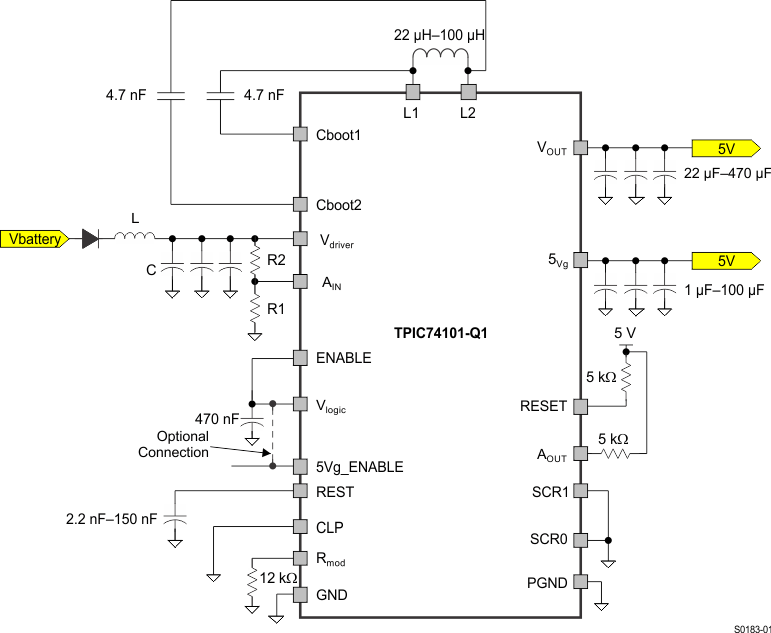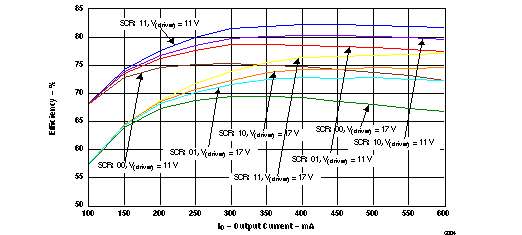ZHCS483A October 2011 – December 2014 TPIC74101-Q1
PRODUCTION DATA.
- 1 特性
- 2 应用
- 3 说明
- 4 修订历史记录
- 5 Pin Configuration and Functions
- 6 Specifications
-
7 Detailed Description
- 7.1 Overview
- 7.2 Functional Block Diagram
- 7.3
Feature Description
- 7.3.1 Switch-Mode Input/Output Pins (L1, L2)
- 7.3.2 Supply Pin (Vdriver)
- 7.3.3 Internal Supply Decoupling Pin (Vlogic)
- 7.3.4 Input Voltage Monitoring Pin (AIN)
- 7.3.5 Input Undervoltage Alarm Pin (AOUT)
- 7.3.6 Reset Delay Timer Pin (REST)
- 7.3.7 Reset Pin (RESET)
- 7.3.8 Main Regulator Output Pin (VOUT)
- 7.3.9 Low-Power-Mode Pin (CLP)
- 7.3.10 Switch-Output Pin (5Vg)
- 7.3.11 5Vg-Enable Pin (5Vg_ENABLE)
- 7.3.12 Slew-Rate Control Pins (SCR0, SCR1)
- 7.3.13 Modulator Frequency Setting (Pin Rmod)
- 7.3.14 Ground Pin (PGND)
- 7.3.15 Enable Pin (ENABLE)
- 7.3.16 Bootstrap Pins (Cboot1 and Cboot2)
- 7.4 Device Functional Modes
- 8 Application and Implementation
- 9 Power Supply Recommendations
- 10Layout
- 11器件和文档支持
- 12机械封装和可订购信息
封装选项
机械数据 (封装 | 引脚)
- PWP|20
散热焊盘机械数据 (封装 | 引脚)
- PWP|20
订购信息
8 Application and Implementation
NOTE
Information in the following applications sections is not part of the TI component specification, and TI does not warrant its accuracy or completeness. TI’s customers are responsible for determining suitability of components for their purposes. Customers should validate and test their design implementation to confirm system functionality.
8.1 Application Information
The TPIC74100-Q1 is a switch-mode regulator with integrated switches for voltage-mode control. With the help of external LC components, the device regulates the output to 5V +-2% for a wide input voltage range. The device can monitor the output voltage as well as the input voltage.
8.2 Typical Application

8.2.1 Design Requirements
Plot the converter efficiency with four different slew rate controls (SCRx) at an input voltage of 11 V and 17 V. The slew rate of the switching transistor Q1 can be changed using the SCR0 and SCR1 pins.
8.2.2 Detailed Design Procedure
8.2.2.1 Buck Mode
- Select inductor ripple current ΔIL: for example ΔIL = 0.2 × IOUT
- Calculate inductor L
- Inductor peak current
- Output voltage ripple

where fSW is the regulator switching frequency.


Usually, the first term is dominant.

8.2.2.2 Boost Mode
- Select inductor ripple current ΔIL: for example ΔIL = 0.2 × IIN
- Calculate inductor L
- Inductor peak current
- Output voltage ripple

where fSW is the regulator switching frequency.


8.2.3 Application Curves

NOTE:
The average converter efficiency with four different slew rate controls (SCRx) on the Q1 switching FET with input voltage V(driver) = 11 V and 17 V, TA = 125°C.